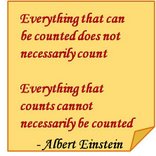First things first - To those of you who are still hanging around here in some hope of seeing a post – my apologies for disappearing!
********************************************************************************
In my 1st post on the subject, I used the Art metaphor to show how the skills required by commercial qual researchers become subconscious after a certain level of proficiency is reached and perhaps that is the reason why knowledge in this field is mostly acquired by observation and through word of mouth rather than through any formally documented way. Perhaps that is also the reason why it is often misconstrued to be unscientific in nature.
I use the metaphor once again today to bring up the question of 'Reliability'
When the topic of qual research is being discussion it is not uncommon to hear that - if two qual researchers are asked study a subject and report findings, you'd could hear two or more differing views. This can be confounding and often leads to people questioning the 'reliability' (repeatability / consistency) of research.
Going back to the metaphor - if 3 people were asked to paint the same subject - let’s say the Statue of Liberty, would we see identical results by all 3 artists? In all likelihood we would NOT! Could we then assume that one or the other has painted the picture wrong? The answer to that is again a NO.
The artist picks up a slice of the reality that is in front of him and reproduces it on canvas with the intention of expressing what he saw. One focuses on the face - trying to capture the emotions that the monument symbolizes, the other focuses on the context & captures the backdrop against which the monument stands, the 3rd captures the technical prowess behind the monument.
The purpose of qual research is to understand the meaning that consumers attribute to their experiences around brands / products and that meaning is very much a part of the consumer's subjective reality. There is no one definite way of looking at a brand /product; we look at things through the filter of our own experiences & past associations. And one of the objectives of qual research is to explore the many possible ways in which consumers perceive and create reality rather than limiting the canvas to the dominant and commonly held perceptions.
In fact if a consumer is asked to narrate a memory around an experience on two occasions - the recollections would most likely be different since memory is not static, it is dynamically created by bringing together associations based on the stimulus or trigger. When researchers report things differently - they are attempting to recreate the reality they have seen / heard.
Planning / Designing Research
As a researcher I have often been told "we would like to do 4 groups amongst these respondents in these 2 cities". While planning research - we often go by past research done on a subject as a benchmark...use similar methods, geographies, talk to the same people. Research proposals and discussion guides are pulled out from earlier studies and minimally tweaked to suit new ones. The result is anybody’s guess - we hear the same sort of responses which were heard a while ago with little incremental value added by the new research. This can be partly attributed to the assumption we make while planning i.e. since we are studying the same subject matter using the same research design would not be out of line and partly to lazy thinking.
Planning is one of the most important steps in a research project which sadly gets overshadowed due to the lack of time.
Even if the subject of the painting is the same – the vision that an artist has of the painting will determine what he decides to capture on his canvas and the tools / colors he uses to translate that vision.
Likewise the objective of research will determine the research design. For instance – lets take a research that needs to be designed for a brand of tea – if the purpose of the research is to understand the consumer & her mindset to design communication – it would be best to talk to her individually. If one needs to understand her context / interaction with the product – talking to her could be supplemented by observations. If the purpose is to understand the significance of the product in a culture and how that has changed over time – a consumer interaction may not be the ideal way forward. A semiotic study may have to be undertaken.
The idea is to look at each piece of research with the fresh perspective - to adopt a ‘solution - neutral approach’ – narrow down on the slice of the subject area to be studied and then arrive at the design that will best capture the information you want. And not the other way around.
Leigh Ausband, author of the paper Qualitative Research and Quilting uses a very simple example to emphasis the importance of planning….
I look at some quilts where I rushed, where I used a fabric I had on hand instead of waiting until I could get to the fabric store to purchase just the right piece…those quilts could have had a better outcome; they could have been richer in color or had more texture. However, I rushed and got less-than-satisfactory results. That is a lesson to be remembered. I will keep on working at gaining access, remembering that this project will be better and richer if I can get more participants, and get the right participants, the participants that can contribute the most to the project
Improper / inadequate planning
=
Compromising on the inputs that go into the creation of anything
(in case of research - research method, research instrument & participants)
=
A less than perfect output
Technorati Tags :




No comments:
Post a Comment